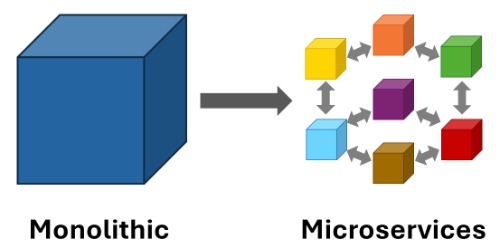
[ad_1]
Legacy programs are sometimes enormous, monolithic purposes developed over a protracted interval. These purposes can turn out to be arduous to keep up and are an inefficient use of assets, signaling that it could be time emigrate to cloud infrastructure and reap the benefits of fashionable microservice expertise. As soon as deployed, microservice structure helps organizations stay versatile and environment friendly whereas isolating providers and functionalities. Right now, quite a lot of out there cloud options can allow firms of any measurement to transition to cloud-based microservice architectures.


Microservices
The elevated flexibility and simplification supplied by microservices architectures signify important benefits. Microservices are designed and developed to maintain providers remoted and unbiased of one another. Whereas there are cloud applied sciences and databases that permit these providers to speak and share info internally, the first aim is to isolate providers.
A major profit is the power to scale purposes up or down. For instance, suppose there’s a sudden load to the add operation. In that case, microservices architectures allow load balancing to distribute visitors throughout servers to enhance system efficiency with out increasing unused operations like updating or deleting. Customers solely pay for what’s used, saving each assets and prices.
As a result of providers are stored unbiased, a microservice structure can combine rising applied sciences extra simply. New options and features might be developed and carried out with out impacting different providers. In monolithic architectures, providers are extra carefully tied, making it difficult to make updates or modifications with out risking unintentional impacts on non-target programs. Functions in monolithic architectures is likely to be simple to develop and handle, however they’re tightly coupled, which makes updates difficult since purposes are likely to get larger over time and, in some unspecified time in the future, it turns into arduous to make any modifications in any respect.
Implementing or transitioning to a microservices structure does require time, data, and funding. Efficient architectures necessitate an understanding of the newest cutting-edge cloud options and applied sciences, and since every service has its lifecycle of growth, deployment, and upkeep, there’s extra overhead. Nonetheless, when performed appropriately, this greater preliminary value will enhance effectivity, particularly on the manufacturing stage. Microservice architectures present flexibility so organizations can shortly broaden completely different providers or options as wanted.
Cloud Options
The rise of cloud computing has enabled extra widespread adoption of microservices structure, particularly with on-demand scalability. As with microservices, considered one of cloud infrastructure’s important advantages is that it permits companies to scale their computing assets up or down as wanted. Cloud-based microservices usually embody logging and tracing info by default, offering organizations with extra info than a monolithic structure about how the packages are getting used.
Information is an more and more useful useful resource for organizations in all industries, and they’re gathering and producing growing quantities of knowledge. In a current article, McKinsey predicted widespread “information ubiquity” by 2030, which refers back to the growing quantity and entry to up-to-date information and its progressively vital position in practically all processes, programs, and choices organizations make.
Based on a report from Deloitte on the present and future use of the cloud, 86 % of surveyed organizations already use the cloud for information analytics and administration, and 74 % use it along with synthetic intelligence (AI) or machine studying (ML). AI and ML algorithms are among the many greatest instruments out there for locating helpful patterns in giant information, and the out-of-the-box AI capabilities supplied by cloud suppliers permit companies of any measurement to harness the ability of those rising applied sciences to garner insights instantly. As soon as an organization turns into extra strong and established, constructing a customized AI or ML mannequin with customized logic could provide a greater return on the funding (ROI). Within the meantime, these in-built cloud options might help organizations keep on prime of fixing expertise tendencies.
Microservices Adoption
Probably the most important step for organizations transitioning from a monolithic to a microservice structure is to make sure all purposes and enterprise operations are correctly decoupled. Whereas cloud expertise is a crucial a part of a microservices method, merely importing current programs doesn’t imply it has been transitioned to microservices. For every service to be individually deployable, updatable, and scaled up or down, organizations first must decouple any tightly tangled legacy providers.
Organizations can suppose huge however implement small. Whereas modern and environment friendly objectives are essential, purposes are considered in remoted, granular phrases. Unbiased providers are the muse of microservice structure. Including too many options right into a single utility will shortly revert organizations to a monolithic framework. As a substitute, new providers might be added as wanted.
Microservices architectures are more and more frequent and plenty of giant organizations like Netflix, Uber, and Spotify. In a Gartner survey, practically three-quarters of respondents stated their group already makes use of microservices. Small and midsize firms involved in regards to the problem of migrating to microservices don’t must reinvent the wheel. For instance, final 12 months, the state of Utah’s Workplace of Restoration Providers (ORS) migrated its case administration and accounting system fully right into a public cloud. The company used an automatic refactoring software emigrate each the code and information and now has entry to varied cloud-native applied sciences, together with AI, course of automation, and information analytics. Like ORS, organizations can make the most of the cloud-based instruments and options cloud suppliers have developed to simplify the transition to microservices and cloud programs.
Ultimately, it’s important for organizations to make choices primarily based on their distinctive wants. For any firm, no matter measurement or trade, transitioning to a cloud-based microservice structure is value consideration. Microservices architectures are usually not depending on a single or particular useful resource for the entire system, enabling organizations to be extra agile and modern. With the cloud, firms can entry out-of-the-box capabilities like AI, elevated information, and superior safety features that might require important funding to construct themselves.
[ad_2]
Supply hyperlink







